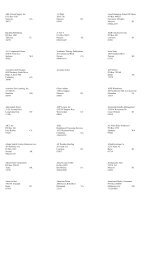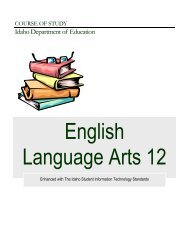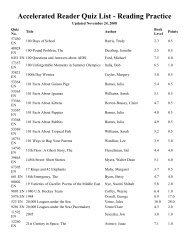You also want an ePaper? Increase the reach of your titles
YUMPU automatically turns print PDFs into web optimized ePapers that Google loves.
END OF COURSE ASSESSMENT<br />
Idaho Department of Education<br />
PROCTOR BOOK<br />
Economics
Published by the Idaho Department of Education<br />
Fall 2002<br />
Dr. Marilyn Howard<br />
State Superintendent of Public Instruction
Instructions for the <strong>Proctor</strong><br />
Introduction<br />
The purpose of this test is to assess the knowledge and understanding of students who<br />
have completed the 12 th grade course of study in economics. This test is designed to measure the<br />
following standards from the Idaho State Achievement Standards for Social Studies -<br />
Economics: 489.01, 510.01, 511.01, 512.01, 513.01, 514.01. The results of this test will be used<br />
to assess the student’s mastery of the achievement standards and determine the student’s<br />
readiness for further study. The complete assessment package for this course of study is made<br />
up of multiple components:<br />
♦ Written Test. This written test includes multiple-choice test items and restrictedresponse<br />
essays. The correct answers are shown in red. An answer key for essay<br />
questions is at the end of this guide.<br />
Preparation<br />
During the Test<br />
1. Read the following. After all materials have been distributed to each examinee, read<br />
the following instructions before the test is allowed to begin:<br />
The purpose of this test is to assess your knowledge and understanding of the<br />
terms and concepts of Economics. You must finish the exam by the end of the exam<br />
period. Except for emergencies, you will not be allowed to leave the testing area <strong>with</strong><br />
the intent of returning to complete the exam.<br />
Read all directions for each set of items as you complete this exam. Your grade<br />
will be computed using the number of items answered correctly. Therefore, you<br />
should record an answer for every item. You must do your own work. Cheating will<br />
result in a score of 0 being recorded for this exam.<br />
When you have finished your exam, please turn all test materials in to me before<br />
you leave the testing area.<br />
2. Clarify directions as needed. Allow the examinees to begin as soon as practical.<br />
Allow as much time as possible for each examinee to complete the test.<br />
3. Keep interruptions to a minimum.<br />
4. Avoid giving hints. An examinee may ask to have specific test items clarified.<br />
Avoid the tendency to provide a hint to the answer. To maintain uniformity of test<br />
administration, any assistance provided to one examinee should be repeated for all.<br />
These interruptions should be kept brief and infrequent.<br />
i
Percentage / Cut Scores<br />
The test developers have recommended the following percentages to determine student<br />
proficiency in scoring correct answers for Economics:<br />
• 87% - 100% = Advanced Proficient<br />
• 70% - 86.9% = Proficient<br />
• 60% - 69.9% = Basic<br />
• Below 59.9% = Below Basic<br />
Questions regarding the administration of this end-of-course exam can be directed to:<br />
Dr. Carolyn Mauer, Bureau of Curriculum and Accountability or<br />
Dr. Dan Prinzing, Social Studies Coordinator<br />
Idaho Department of Education<br />
ii
End of Course Exam<br />
Economics<br />
Introduction: The purpose of this examination is to assess your knowledge and understanding<br />
of the terms and concepts of economics. You must finish this exam by the end of the<br />
exam period. Except for emergencies, you will not be allowed to leave the testing area<br />
<strong>with</strong> the intent of returning to complete the exam.<br />
Read all directions for each set of items as you complete this exam. Your grade will be<br />
computed using the number of items answered correctly. Therefore, you should record<br />
an answer for every item. You must do your own work. Cheating will result in a score<br />
of 0 being recorded for this exam.<br />
Directions: For items 1—69, select the best answer from the alternatives provided.<br />
1. A financial arrangement allowing purchase and use now and payment later<br />
a. Budget<br />
b. Credit<br />
c. Rebate<br />
d. Garnishment<br />
2. Someone who combines land, labor, and capital resources in a creative way, assuming<br />
risk in return for a chance to profit, is a/an<br />
a. employee.<br />
b. worker.<br />
c. consumer.<br />
d. entrepreneur.<br />
3. The various quantities of a good which producers are willing and able to offer for sale at<br />
a given time at different possible prices is<br />
a. a shift in supply.<br />
b. supply.<br />
c. elasticity of supply.<br />
d. a change in quantity supplied.<br />
4. This states that at higher prices consumers generally buy small quantities, and at lower<br />
prices consumers tend to buy larger quantities.<br />
a. Law of demand<br />
b. Law of supply<br />
c. Law of increasing costs<br />
d. Law of diminishing returns<br />
1
5. The degree to which a price change of a good alters the quantity purchased of that good is<br />
a. diminishing marginal utility.<br />
b. a change in demand.<br />
c. the price elasticity of supply.<br />
d. the price elasticity of demand.<br />
6. An increase or decrease in quantities producers offer for sale at each and every price as a<br />
result of a change in an input cost is a<br />
a. diminishing marginal utility.<br />
b. change in quantity demanded.<br />
c. shift or change in supply.<br />
d. shift or change in demand.<br />
7. The condition occurring in a market when the price is above the equilibrium or marketclearing<br />
price is<br />
a. voluntary exchange.<br />
b. a shortage.<br />
c. scarcity.<br />
d. a surplus.<br />
8. A type of economic system in which the questions of what to produce, how much to<br />
produce, how to produce, and who will get the products, is answered by individuals<br />
consumers and producers is a<br />
a. market economy.<br />
b. traditional economy.<br />
c. command economy.<br />
d. mixed economy.<br />
9. In the world of trade this is enjoyed by the producers who are able to produce an item at a<br />
lower opportunity cost than their competitors is<br />
a. dumping.<br />
b. a trade barrier.<br />
c. a comparative advantage.<br />
d. trade imbalance.<br />
2
10. A form of business organization which furnishes limited liability for owners, unlimited<br />
life for the firm, and the ability to raise large amounts of money capital is a<br />
a. sole proprietorship.<br />
b. corporation.<br />
c. partnership.<br />
d. limited-liability company.<br />
11. A type of investment which confers ownership to the investors, and a chance to profit via<br />
dividends and capital gains is a/an<br />
a. U.S. treasury security.<br />
b. certificate of deposit.<br />
c. corporate bond.<br />
d. common stock.<br />
12. The monetary policy tool of the Fed which involves buying or selling U.S. treasury<br />
securities is<br />
a. the discount rate.<br />
b. the reserve requirement.<br />
c. open-market operations.<br />
d. automatic stabilizers .<br />
13. What does the law of demand predict about the relationship between prices and the<br />
number of purchases?<br />
a. At higher prices, sellers will offer more items for sale than at lower prices.<br />
b. At higher prices, buyers will purchase more items than at lower prices<br />
c. At lower prices buyers will purchase more items than at higher prices.<br />
d. At lower prices sellers will offer more items than at higher prices.<br />
14. A change in quantity demanded is caused by and represented graphically as a<br />
a. change in price of item of interest; shift of curve to right.<br />
b. change in price of item of interest; movement along the curve.<br />
c. change in price of item of interest; shift of curve the left.<br />
d. no change in price of item of interest; movement along the curve.<br />
15. The likely result of a price floor (i.e. minimum wage) is which of the following?<br />
a. A shortage of workers<br />
b. No change in the equilibrium quantity of workers<br />
c. The quantity demanded would be equal to the quantity supplied of workers<br />
d. A surplus of workers<br />
3
16. Which of the following is the basic reason for countries to engage in international trade?<br />
a. Benefit to one trading country<br />
b. Mutual benefit from exchange<br />
c. Benefit to neither trading country<br />
d. Government regulation<br />
17. Engaging in international trade results in which of the following?<br />
a. More efficient use of scarce global resources<br />
b. Less efficient use of scarce global resources<br />
c. No change in efficiency of global resource use<br />
d. Total satisfaction of all parties involved<br />
18. The economic system of the United States is best described as<br />
a. Mixed<br />
b. Traditional<br />
c. Market<br />
d. Command<br />
19. Which of the following is an important advantage of a sole proprietorship?<br />
a. Lack of money capital<br />
b. Psychological (being own boss)<br />
c. Unlimited liability<br />
d. Limited life<br />
20. Which of the following is an important disadvantage of a corporation?<br />
a. Unlimited life<br />
b. Limited life<br />
c. Ability to raise money capital<br />
d. High cost of start-up<br />
21. The stock market in general may be defined as which of the following?<br />
a. An organized means of linking savers and business investors.<br />
b. A convenient way to lose money<br />
c. A government owned enterprise<br />
d. The cause of the great depression<br />
4
22. How does the stock market in general assist the global economy?<br />
a. Sets interest rates<br />
b. Widens the gap between developed and undeveloped countries<br />
c. Allows money capital to travel where it is most needed<br />
d. Discourages diplomatic relationships among countries<br />
23. Basic monetary policy deals <strong>with</strong> which of the following?<br />
a. Changing tax laws<br />
b. Changing the amount of money circulating in the economy<br />
c. Changing government spending<br />
d. Placing tariffs on imports<br />
24. If the Federal Reserve (Fed) wishes to increase the supply of money circulating in our<br />
economy, it would do which of the following?<br />
a. Sell U.S. government securities<br />
b. Increase the discount rate<br />
c. Increase the reserve requirements<br />
d. Buy U.S. government securities.<br />
25. An amount of money offered by a credit user to reduce the initial amount borrowed on a<br />
loan is called a/an<br />
a. line of credit.<br />
b. finance charge.<br />
c. down payment.<br />
d. APR.<br />
26. A credit card is a form of<br />
a. revolving credit.<br />
b. single payment credit.<br />
c. installment credit.<br />
d. debit card.<br />
27. The figure required by law to appear on all loan forms is the<br />
a. credit record.<br />
b. compound interest.<br />
c. annual percentage rate.<br />
d. credit history.<br />
5
28. A method of interest calculation that uses the principal plus accrued unpaid interest as the<br />
basis for calculating interest in the current time period is known as<br />
a. compound interest.<br />
b. annual percentage rate.<br />
c. simple interest.<br />
d. security interest.<br />
29. A financial institution which is non-profit and whose customers are members is called a<br />
a. commercial bank.<br />
b. credit union.<br />
c. savings and loan association.<br />
d. finance company.<br />
30. Jim was involved in an automobile accident and his car was damaged. The repair bills<br />
totaled $2,000. Jim has insurance for the car <strong>with</strong> a $250 deductible. How much of the<br />
total repair bill will Jim have to pay?<br />
a. $2,250<br />
b. $2,000<br />
c. $500<br />
d. $250<br />
31. An investment option which furnishes the investor diversification, professional<br />
management and a variety of goal choices is known as a<br />
a. certificate of deposit.<br />
b. preferred stock.<br />
c. mutual funds.<br />
d. common stock.<br />
32. A form or type of tax characterized by a lower tax rate for lower incomes and a higher tax<br />
rate for higher incomes is called a/an<br />
a. regressive tax.<br />
b. revenue tax.<br />
c. progressive tax.<br />
d. excise tax.<br />
33. Initially labor unions were organized to do all of the following except:<br />
a. improve safety and working conditions.<br />
b. increase wages and benefits.<br />
c. decrease taxes.<br />
d. promote job security.<br />
6
34. Jane bought a dress for the homecoming dance. When she got home she found a flaw in<br />
the fabric and became distressed. Jane should<br />
a. contact her attorney.<br />
b. find someone who can correct the problem.<br />
c. take the dress back to the merchant.<br />
d. write a letter of complaint to the manufacturer.<br />
35. In order to establish a credit history a consumer must<br />
a. attend courses in the history of credit.<br />
b. use credit over a period of time to show payment activity.<br />
c. apply for credit history at a local savings and loan.<br />
d. all of the above.<br />
36. Credit card companies make money from all of the following EXCEPT<br />
a. interest paid by credit card holders.<br />
b. fees paid by stores.<br />
c. taxes paid on purchase of goods.<br />
d. annual fees paid by credit card holders.<br />
37. When considering a bank <strong>with</strong> which to do business,<br />
a. consider services offered and costs involved.<br />
b. be sure the bank is conveniently located <strong>with</strong> adequate hours.<br />
c. check for their FDIC credentials.<br />
d. all of the above.<br />
38. Todd borrows $500 for one year at 15% simple interest. How much interest is paid<br />
monthly?<br />
a. $43.5l<br />
b. $8.65<br />
c. $75.00<br />
d. $6.25<br />
39. Sue’s disposable income is $1,100 per month before she takes out a new car loan for<br />
$10,000, <strong>with</strong> a monthly payment of $300. What is Sue’s disposable income after she<br />
borrows for the new car?<br />
a. $300<br />
b. $800<br />
c. $1,100<br />
d. $11,100<br />
7
40. The cost of borrowing money is paid by consumers as<br />
a. taxes.<br />
b. principal.<br />
c. product costs.<br />
d. interest.<br />
41. What roll has the Federal Deposit Insurance Corporation played in banking services?<br />
a. Required federal testing for all bank employees<br />
b. Established federal statutes for bank vault construction<br />
c. Provided safety of principal from loss up to $l00,000 per account<br />
d. Allowed safe deposit records to remain anonymous<br />
42. What are the three types of <strong>with</strong>holdings taken from the typical wage earners paycheck?<br />
a. Federal taxes, state taxes, FICA<br />
b. Federal taxes, county taxes, FICA<br />
c. Federal taxes, state taxes, county taxes<br />
d. County taxes, state taxes, FICA<br />
43. Whose purchasing power declines most in times of inflation?<br />
a. Borrowers<br />
b. People on fixed incomes<br />
c. Government<br />
d. People <strong>with</strong> part-time jobs<br />
44. Consumers who borrow money must generally accept which of the following<br />
consequences?<br />
a. Lower living standard<br />
b. Higher total cost for the item purchased<br />
c. Inconvenience in purchasing goods<br />
d. Greater ability to save on income tax<br />
45. Consumers who abuse credit and end up taking out a consolidation loan may generally<br />
end up paying<br />
a. less interest.<br />
b. equal interest.<br />
c. no interest.<br />
d. more interest.<br />
8
46. What is the universal economic problem that forces all of us to make choices in a world<br />
of limited resources and unlimited wants?<br />
a. Marginal cost<br />
b. Allocation<br />
c. Scarcity<br />
d. Trade-offs<br />
47. When we give up one thing to gain another, it is called the<br />
a. opportunity cost.<br />
b. marginal cost.<br />
c. marginal benefit.<br />
d. production-possibilities frontier.<br />
48. The additional or extra expense of producing one more item is called<br />
a. marginal cost.<br />
b. opportunity cost.<br />
c. explicit costs.<br />
d. variable cost.<br />
49. The essential ingredients or requirements needed to produce any product or service are<br />
referred to as<br />
a. macroeconomics.<br />
b. microeconomics.<br />
c. basic economic questions.<br />
d. factors of production.<br />
50. An economic model or tool which shows visually the output potential given a limited<br />
amount of resources and a given technological condition is a<br />
a. demand curve.<br />
b. circular flow chart.<br />
c. budget line.<br />
d. production possibilities frontier.<br />
51. The branch of economics which deals <strong>with</strong> issues, policies, and wants relating to an<br />
individual or a business firm is<br />
a. macroeconomics.<br />
b. microeconomics.<br />
c. international economics.<br />
d. supply-side economics.<br />
9
52. Money serves which the following purposes or functions?<br />
a. medium of exchange.<br />
b. standard or measure of value.<br />
c. store of value.<br />
d. all of the above.<br />
53. Relating to the human economic condition, which of the following is virtually limitless?<br />
a. Money<br />
b. Needs<br />
c. Wants<br />
d. Goods<br />
54. That portion of the economy made up of individuals, businesses, and non-government<br />
entities is the<br />
a. public sector.<br />
b. private sector.<br />
c. Federal Reserve.<br />
d. Internal Revenue Service.<br />
55. The basic economic problem is<br />
a. poverty.<br />
b. scarcity.<br />
c. unemployment.<br />
d. inflation.<br />
56. The opportunity cost of doing your homework rather than going to the basketball game is<br />
a. watching the game.<br />
b. unimportant since money is not involved.<br />
c. nothing since homework is more important.<br />
d. having your homework completed.<br />
57. Which of the following is a characteristic of an entrepreneur?<br />
a. Not necessary in the production process.<br />
b. Protected from loss by producing only profitable output.<br />
c. Anyone who is part of the production process.<br />
d. A risk taker who combines the other factors of production.<br />
10
58. In a market economy the questions of what, how and for whom to produce are answered<br />
by<br />
a. traditions and customs.<br />
b. a central planning agency.<br />
c. individuals primarily, producers secondarily.<br />
d. producers only.<br />
59. In a command economy the questions of what, how, and for whom to produce are<br />
answered by<br />
a. traditions and customs.<br />
b. a central planning agency.<br />
c. individuals.<br />
d. producers.<br />
60. The incentive(s) to produce in a market economy is/are<br />
a. quotas.<br />
b. government forecasts.<br />
c. profit.<br />
d. altruism.<br />
61. The process of choosing which of our needs and wants will be satisfied and how much of<br />
our resources will be used to satisfy them is called<br />
a. opportunity cost.<br />
b. capitalism.<br />
c. scarcity.<br />
d. allocation.<br />
62. If prices increase by 10% during a period when wages increase by 5%, what function of<br />
money is primarily being affected?<br />
a. Store of value<br />
b. Deflation<br />
c. Medium of exchange<br />
d. Inflation<br />
63. When some European countries agreed to replace their money <strong>with</strong> the Euro, what<br />
function of money was primarily being affected?<br />
a. Store of value<br />
b. Measurement of value<br />
c. Medium of exchange<br />
d. Inflation<br />
11
64. The public sector is best suited to deal <strong>with</strong> externalities because it<br />
a. has power to make and enforce laws.<br />
b. creates the externalities.<br />
c. has money to pay for damages.<br />
d. represents all of the people.<br />
65. One problem associated <strong>with</strong> public goods is<br />
a. improving private sector efficiency.<br />
b. they cost more than private goods.<br />
c. free riders.<br />
d. having too many public goods when taxes decline.<br />
66. Which of the following statements represents a function of the public sector?<br />
a. Defines and enforces property rights<br />
b. Redistributes income<br />
c. Promotes competition<br />
d. All of the above<br />
Items 67—69 refer to the following sketch: Mary wants to start a business making shirts, she<br />
will put her own logo on them and sell them for twice what it costs her to make them.<br />
Mary has purchased some cotton fabric and owns a sewing matching.<br />
67. The sewing machine represents which factor of production?<br />
a. Land<br />
b. Labor<br />
c. Capital<br />
d. Entrepreneurship<br />
68. The cotton fabric represents which factor of production?<br />
a. Land<br />
b. Labor<br />
c. Capital<br />
d. Entrepreneurship<br />
69. When Mary hires an employee, the employee would represent which factor of<br />
production?<br />
a. land<br />
b. labor<br />
c. capital<br />
d. entrepreneurship<br />
12
Directions: Complete each of the following Activities. Record your answers in the appropriate<br />
space on the written response sheet provided.<br />
70. Given the following market scenario illustrated by the supply/demand graph below, do<br />
the following:<br />
a. Explain whether the market condition created is a surplus or a shortage.<br />
b. Calculate how large (the quantity) that surplus or shortage will be.<br />
c. Explain in a free market whether price will tend to rise or fall. Why will price adjust?<br />
$Bushel<br />
Wheat<br />
$8<br />
$7<br />
D<br />
S<br />
$6<br />
$5<br />
Price floor (e.g. farm subsidy or<br />
minimum wage)<br />
$4<br />
$3<br />
$2<br />
$1<br />
1 2 3 4 5 6 7 8<br />
(Bushels 000)<br />
13
End of Course Exam <strong>Answer</strong> <strong>Key</strong><br />
Economics<br />
Test Item<br />
Number<br />
70. a. Surplus<br />
Correct <strong>Answer</strong><br />
70. b. 6–3=3<br />
70. c. Price will tend to fall to rid the market of the surplus.<br />
14














